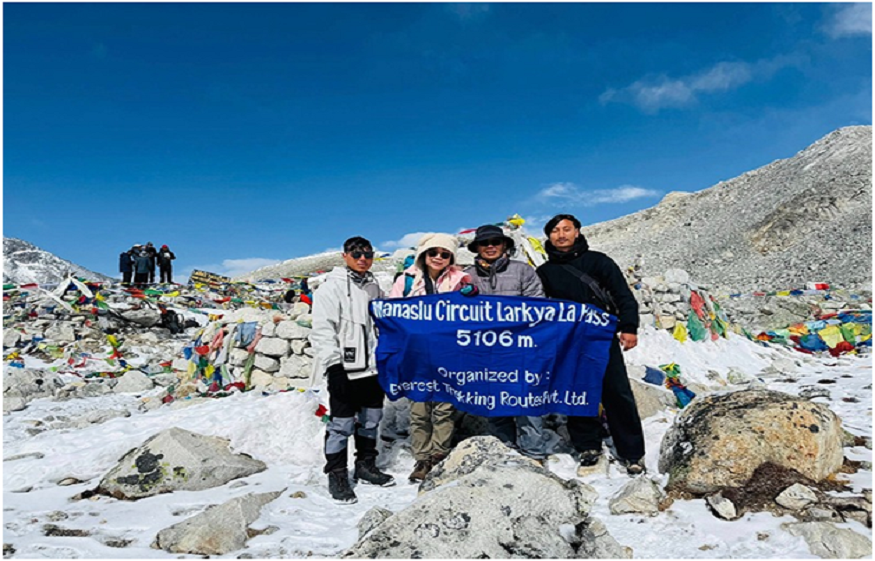Nepal is a country of towering peaks, lavish valleys, and otherworldly lavishness. With eight of the world’s most noteworthy mountains, Nepal has long been a trek for trekkers and travelers looking for the extreme elude. However, past Everest, Nepal offers a range of picturesque, socially immersive, and less-trodden trekking trails that uncover the genuine soul of the Himalayas. Among them, the 5-Day Langtang Valley trek, the separated Nar Phu Valley trek, the emotional Manaslu Circuit trek, and the classic however advancing Annapurna Circuit trek stand out as crown gems for those who pine for a blend of normal ponder and social depth.
These treks are more than physical ventures; they are encounters that offer otherworldly reflection, social inundation, and nature at its most glorious. Whereas a few are moderately brief and open, others request perseverance and commitment. Still, all remunerate their explorers with a bona fide cut of Himalayan life—villages untouched by time, trails that wind through rhododendron woodlands and elevated deserts, and sees of snow-capped peaks that extend past the imagination.
Let us presently investigate these momentous courses one by one, finding what makes each a picturesque perfect work of art in the fantastic Himalayan canvas.
5-Day Langtang Valley trek:
For trekkers brief on time but wealthy in eagerness, the 5 days Langtang Valley trek conveys a concentrated Himalayan encounter in five days. Starting a few hours’ drive north of Kathmandu in Syabrubesi, the path climbs through the heart of Langtang National Stop, a region known for its assorted natural life and rich forests.
The trek passes through thick rhododendron and oak woods, climbing nearby the Langtang Khola stream. The path takes trekkers te Llama Inn, Langtang Town, and at long last Kyanjin Gompa, a high-altitude settlement settled underneath the sensational flanks of Langtang Lirung (7,227m). This last goal is both profoundly and outwardly striking, advertising all encompassing sees and a peaceful cloister at the foot of the glacier.
Trekkers can select to climb up Tserko Ri (4,984m) for dawn or investigate the encompassing frigid moraines and yak pastures. The seas of encompassing peaks and ice sheets equal those of more requesting treks, and the brief agenda makes this trek idealize for fledglings or families.
Beyond normal excellence, the Langtang region’s Tamang culture includes a one of a kind measurement. Their neighborliness and conventional Buddhist traditions give the travel an enthusiastic and social lavishness. In addition, trekking here contributes straightforwardly to communities still recouping from the 2015 earthquake.
Nar Phu Valley trek:
Tucked between the prevalent Annapurna Circuit and the Manaslu region lies one of Nepal’s most separated trekking experiences—the Nar Phu Valley trek. As it was opened to pariahs in 2002, this confined region is a treasure trove of Tibetan Buddhist culture, medieval stone towns, and otherworldly landscapes.
The trek starts in Koto, close to Chame on the Annapurna path, but rapidly separates into the Nar Khola valley. As trekkers climb into the good countries, the advanced world blurs absent. Pine timberlands allow way to fruitless edges and dry valleys where spiked cliffs linger and yaks touch. The medieval towns of Phu and Nar, both roosted over 4,000 meters, offer a uncommon see into protected Himalayan life where supplication wheels turn and antiquated gompas sit watchfully over stone homes.
One of the highlights of the trek is crossing Kang La Pass (5,322m), from where the Annapurna extends bursts into full sea, advertising a jaw-dropping difference between the bone-dry scenes behind and the snow-covered peaks ahead.
Due to its inaccessible area and rough landscape, the Nar Phu Valley trek is best suited to prepared trekkers or those with a profound interest in Tibetan culture. The path requires uncommon licenses and an authorized direct, but the travel is worth each step. It remains one of the least-traveled however most fulfilling treks in Nepal.
Manaslu Circuit trek:
For those who look for a sensational experience absent from the commercial trekking swarms, the Manaslu Circuit trek is a grand and physically requesting trip. This trek circles Mount Manaslu (8,163m)—the eighth-highest peak in the world—and takes you through a few of Nepal’s most inaccessible and untouched villages.
Starting in Soti Khola, the path takes after the effective Budhi Gandaki Stream, continuously climbing through subtropical timberlands, soak gorges, and tall snow capped glades. Along the way, towns like Namrung, Lho, Samagaon, and Samdo offer social lavishness formed by solid Tibetan impacts. Old cloisters, supplication banners, mani dividers, and chortens are found all through the course, inundating trekkers in otherworldly ambiance.
The gem of the trip is the crossing of Larkya La Pass (5,106m). This challenging climb offers a wild and uncovered scene with all encompassing sees of Himlung Himal, Cheo Himal, and Annapurna II. The plummet into the Marsyangdi Valley is similarly beautiful, interfacing to the lower trails of the Annapurna region.
The Manaslu Circuit trek is idealized for trekkers looking for a mix of inaccessible culture, serious physical challenge, and staggering view. Since it passes through a limited range, an extraordinary allow and direct are required, and the path regularly takes 14 to 18 days. It’s a crude, effective trek that conveys Nepal in its purest form.
Annapurna Circuit trek:
The Annapurna Circuit trek is frequently cited as one of the best long-distance treks in the world—and for great reason. Advertising uncommon differences in scenes, societies, and elevation, this path is a trek through the heart of Nepal’s central Himalayas.
Traditionally beginning in Besisahar, the course takes after the Marsyangdi Stream up through lavish terraced farmland and Hindu towns. As you rise, the scene moves to snow capped pine timberlands and inevitably to the Tibetan-influenced towns like Manang, which sits at an height of 3,540 meters. Trekkers regularly take an acclimatization day here, investigating the Ice Lake or Gangapurna Lake.
The trek’s most emotional challenge is crossing Thorong La Pass (5,416m)—the most noteworthy point on the course. At this height, the discussion is lean, but the sees are endless: perpetual snow peaks, frosty valleys, and a sense of significant remoteness. The plummet into Muktinath, a sacrosanct trek location, presents trekkers to the dry Bronco region, with its windswept landscape and sensational cliffs.
From here, the path proceeds through Kagbeni, Jomsom, and Tatopani, where characteristic hot springs offer revival. Numerous trekkers wrap up the trip with a climb to Poon hill, eminent for its all encompassing dawn views over Dhaulagiri and the Annapurna range.
While advancement and street development have modified parts of the path, numerous beautiful choices protect its realness. The Annapurna Circuit remains a fabulous travel destination, combining wealthy social experiences, striking topographical differing qualities, and a few of Nepal’s finest mountain vistas.
What Makes These Treks Beautiful and Special
Each of these four treks paints a diverse representation of the Himalayas:
- Langtang Valley offers insinuate experiences with nature and Tamang culture in a moderately brief time.
- Nar Phu stands out for its otherworldly profundity, segregation, and stark, high-altitude live beauty.
- Manaslu gives a wild, shifted, and challenging involvement with emotional scenes and an effective sense of remoteness.
- Annapurna Circuit is a comprehensive trek through moving scenes and numerous ethnic regions, coming full circle in one of the world’s most famous tall passes.
Together, these treks grandstand Nepal’s picturesque differing qualities: from thick woodlands and stream gorges to frigid moraines, tall mountain passes, and dry levels. They navigate not as it were physical separations but centuries of history and layers of culture.
When to trek and What to Know
Best Seasons:
Spring (March–May): Sprouting rhododendrons, clear skies, and direct temperatures.
Autumn (September–November): Fresh discussion, mind blowing perceivability, and energetic mountain towns post-monsoon.
Winter (December–February) offers isolation and frigid sees but comes with the hazard of closed passes. Storm (June–August) is slightly perfect due to overwhelming rain, avalanches, and leeches.
Permits Needed:
- Langtang: Langtang National Stop Allow + TIMS
- Nar Phu: Confined Region Allow (RAP), ACAP, TIMS, Direct required
- Manaslu: RAP, MCAP, ACAP, Direct + least gather size
- Annapurna: ACAP + TIMS
Trekking Tips and Essentials
- Acclimatization: Never surge elevation pick up. Take rest days and hydrate well.
- Gear: Strong boots, a -10°C resting pack, layered clothing, trekking posts, and headlamp.
- Support: Enlist neighborhood guides and doormen where possible; they improve your encounter and back the nearby economy.
- Sustainability: Carry your squander, dodge plastic bottles, and regard nearby customs.
Conclusion:
The picturesque treks of Nepal—from Langtang to Nar Phu, Manaslu, and Annapurna—form a breathtaking mosaic of everything the Himalayas speak to: peace, control, excellence, and strength. These trails take you through moving scenes and immortal conventions, advertising more than mountain views—they offer minutes of stillness, challenge, and individual awakening.
While each trek has its one of a kind flavor, together they characterize why Nepal is a safe house for trekkers. Whether you’re strolling beneath the shadow of Langtang Lirung, crossing into the sacrosanct lands of Nar Phu, going up against the rough glory of Manaslu, or navigating the shifted universes of the Annapurna Circuit, each path leads to a more profound appreciation of the Earth’s wonders—and of yourself.
So pack your equipment, set your purpose, and step onto the ways that have moved pioneers and drifters for centuries. In Nepal, climbing isn’t a fair trek—it’s a way to meet the mountains, and maybe, your most elevated self.
FAQs
- Is the 5-day Langtang Valley trek reasonable for beginners?
Yes, it is idealized for tenderfoots and those brief on time, with direct elevation and comfortable teahouses.
- Do I require a direct for the Nar Phu Valley Trek?
Yes, it’s a confined region and requires authorized direct and uncommon permits.
- How long does the Manaslu Circuit trek take?
The full circuit takes almost 14–18 days, depending on acclimatization and side trips.
- Is the Annapurna Circuit still worth doing in spite of street construction?
Absolutely. There are elective picturesque trails, and the differences in scene and culture is unmatched.
- Which trek offers the most social immersion?
Nar Phu and Manaslu give the most profound social encounters due to their Tibetan-influenced towns and remoteness.
Contact:
Company address: Everest Trekking Routes Pvt. Ltd.
16 Khumbu, Nayabazaar, Kathmandu, Nepal
Mobile : +977-9843467921 (Rabin)
Email: [email protected]
URL:- www.everesttrekkingroutes.com

